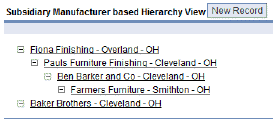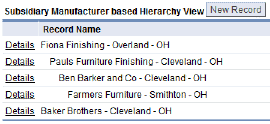Difference between revisions of "Self Reference Lookup"
From LongJump Support Wiki
imported>Aeric |
imported>Aeric |
||
| Line 46: | Line 46: | ||
#Navigate to the object of interest | #Navigate to the object of interest | ||
#In the Forms tab, navigate to the ''Related Information'' section | #In the Forms tab, navigate to the ''Related Information'' section | ||
#Navigate to the ''<object> based Hierarchy View'', click the Edit Related Information [[File:Editlayouticon.gif|link= ]] icon | #Navigate to the ''<object> based Hierarchy View'', click the Edit Related Information [[File:Editlayouticon.gif|link= ]] icon | ||
# | # Fill in the information below. | ||
#Click '''[Save]'''<br>The <object> based Hierarchy View records are displayed in the Related Information section. | |||
;Object based Hierarchy View Information: | |||
:[[File:Objectbasedhierarchyview.gif]] | |||
:;Title:Title of the Related Information section | |||
::*Pre-populated with ''<object> based Hierarchy View'' | |||
::*Optionally, change the Title | |||
:;Fields to Display:Select fields in the list of those Available, and click the right-arrow button to move them to the Selected column; Optionally, click the up- or down-arrow buttons to change the order in which the fields appear | |||
:;Sort By: Choose a field to determine the sort order of the records, and choose either Descending or Ascending order | |||
:;Additional Sort By:Optionally, choose a second-level sort | |||
::*Choose a field to determine the sort order of the records, and choose either Descending or Ascending order | |||
:;Display Type:Choose from Tree or Tabular; Tree is default | |||
::<table> <tr><td>[[File:treeselflookup.gif|none|frame|Tree]]</td> <td> [[File:tabularselflookup.gif|none|frame|Tabular]]</td> </tr></table> | |||
::*If Display Type is Tree, the Mode Type option is displayed | |||
::*'''Mode Type -''' Collapsed or Expanded; Collapsed is default | |||
:;Scrolling Window Size: Define the number of rows to display by selecting a Scrolling Window Size; Choose from: | |||
::*No Scrolling, Show all Rows | |||
::*5 Records, Scroll Window | |||
::*10 Records, Scroll Window | |||
::*20 Records, Scroll Window | |||
::*30 Records, Scroll Window | |||
::*40 Records, Scroll Window | |||
::*50 Records, Scroll Window | |||
===Delete an Object based Hierarchy View=== | ===Delete an Object based Hierarchy View=== | ||
Revision as of 00:34, 16 August 2011
An Object can contain a Lookup field that references the Object itself (i.e. a self reference). This configuration is used to build record hierarchies (parent-child relationships between records) which are displayed in a Related Information section.
- Examples
-
- An organization might have multiple subsidiaries, and some of those companies might also have subsidiary companies
- Employees have reporting relationships, to managers and subordinates
- In manufacturing, parts in a component might have subcomponents (or be part of of a larger component)
- Considerations
-
- When a Self Reference Lookup field is added, a new section is added to Related Information
- The new section is named: <object> based Hierarchy View, where <object> is the Lookup Type, or object name; Learn more: About Objects in Lookup Fields
- The new section is added to all the Forms of the object
- By default, this new section is hidden
- When visible, this section displays a hierarchy view of the records
- A Self Reference Lookup field:
Add a Self Reference Lookup Field to an Object
- Click Designer > Data > Objects > {object}
- Click the Fields tab, click the [New Field] button, and complete the following information:
- Label
- Label to display in the form layout
- Display Type
- Lookup
- Object Name
- Choose the {object} selected in the first step
- Field Name
- Name of the field (Parent {object} is a common choice)
- Section
- Choose a section in the form layout (default selection can be used)
- Complete any other optional fields and click the [Save] button to save your changes
- Click the Forms tab and scroll to the Related Information Section
- Click the Display Settings link in the Related Information Section heading bar
- Move the object labeled: {object} based Hierarchy View to the Visible Objects area
- Click [Save]
Create a Self Reference Lookup between Records
- Navigate to the {object} tab (Company, for example)
- Edit a record, select a Parent Company from the lookup field and Save the record
- Select the record designated as Parent Company
- Scroll down to the Company based Hierarchy View section
- Note that child Companies are displayed in the tree, demonstrating the relationships between records in the Company object
Edit an Object based Hierarchy View
To edit an <object> based Hierarchy View:
- Click Designer > Data > Objects
- Navigate to the object of interest
- In the Forms tab, navigate to the Related Information section
- Navigate to the <object> based Hierarchy View, click the Edit Related Information
 icon
icon - Fill in the information below.
- Click [Save]
The <object> based Hierarchy View records are displayed in the Related Information section.
- Object based Hierarchy View Information

- Title
- Title of the Related Information section
- Pre-populated with <object> based Hierarchy View
- Optionally, change the Title
- Fields to Display
- Select fields in the list of those Available, and click the right-arrow button to move them to the Selected column; Optionally, click the up- or down-arrow buttons to change the order in which the fields appear
- Sort By
- Choose a field to determine the sort order of the records, and choose either Descending or Ascending order
- Additional Sort By
- Optionally, choose a second-level sort
- Choose a field to determine the sort order of the records, and choose either Descending or Ascending order
- Display Type
- Choose from Tree or Tabular; Tree is default
- If Display Type is Tree, the Mode Type option is displayed
- Mode Type - Collapsed or Expanded; Collapsed is default
- Scrolling Window Size
- Define the number of rows to display by selecting a Scrolling Window Size; Choose from:
- No Scrolling, Show all Rows
- 5 Records, Scroll Window
- 10 Records, Scroll Window
- 20 Records, Scroll Window
- 30 Records, Scroll Window
- 40 Records, Scroll Window
- 50 Records, Scroll Window
Delete an Object based Hierarchy View
To Delete an Object based Hierarchy View, delete the field that is associated with this Related Information Section.
- Visit Designer > Objects > {object} > Fields
- Click the field name.
- Click [Delete].
A confirmation dialog opens. - Click [OK] to delete the field.
This is a permanent deletion, and cannot be restored.

